
Topics
Guests
- Nomi Prinsformer investment banker turned journalist. She used to run the European analytics group at Bear Stearns. She is the author of two books Other People’s Money: The Corporate Mugging of America and Jacked: How “Conservatives” Are Picking Your Pocket. She is now a Senior Fellow at Demos.
- Max Fraad Wolffeconomist and writer. He is an instructor at the Graduate Program in International Affairs, New School University. He is a frequent contributor to Huffington Post, Asia Times and the Indypendent.
The nation’s fifth largest investment bank Bear Stearns nearly collapsed last week. It was saved only after the Federal Reserve took extraordinary measures to help JPMorgan purchase the eighty-five-year-old firm. The Fed has become the lender of last resort for other investment banks in a move that marks one of the broadest expansions of the Fed’s lending authority since the 1930s. We speak with Nomi Prins, an author and former investment banker at Bear Stearns, and Max Fraad Wolff, an economist and writer. [includes rush transcript]
Transcript
AMY GOODMAN: We are seeing some of the worst crises we have seen in decades, whether we’re talking about the economy, whether we’re talking about the war, and those two issues, we’re going to take on today.
JUAN GONZALEZ: Yes, we are. Well, Wall Street and the nation’s economy is in a state of crisis. The nation’s fifth largest investment bank Bear Stearns nearly collapsed last week. It was saved only after the Federal Reserve took extraordinary measures to help JPMorgan purchase the eighty-five-year-old firm.
As part of the deal, the Fed put up $30 billion to guarantee Bear Stearns’s riskiest investments. For the first time ever, the Federal Reserve has become the lender of last resort for other investment banks in an effort to prevent firms from going under. It is a move that marks one of the broadest expansions of the Fed’s lending authority since the 1930s. At least ten investment funds, including the fund Carlyle Capital run by the Carlyle Group, have recently collapsed or been forced to sell assets.
Consumers are feeling the effects of the economic crisis everywhere. Food prices are rising. Gas prices have reached all-time highs. The dollar is weakening. Credit card debt is expanding. Home prices are falling. And foreclosures continue to rise.
AMY GOODMAN: A year ago, Treasury Secretary Henry Paulson predicted the fallout from the subprime mortgage crisis was “largely contained.” But now, Alan Greenspan is admitting the current economic crisis will likely be the most wrenching since the end of the Second World War.
And then, there’s the occupation of Iraq, which has just entered its sixth year. The Nobel Prize-winning economist Joseph Stiglitz projects the war will cost at least $3 trillion.
We’re joined right now by two guests. Nomi Prins is with us. She’s a former investment banker turned journalist. She used to run the European analytics group at Bear Stearns. She is the author of two books: Other People’s Money: The Corporate Mugging of America
and Jacked: How “Conservatives” Are Picking Your Pocket. She’s now a senior fellow at the think tank Demos. Max Fraad Wolff is an economist and writer. He is an instructor at the Graduate Program in International Affairs, New School University, here in New York. He’s a frequent contributor to the Huffington Post, Asia Times and The Indypendent.
We welcome you both to Democracy Now! Nomi Prins, this story is personal for you. You worked at Bear Stearns.
NOMI PRINS: Yes, actually, I did. I worked there from 1993 to 2000, so I actually worked there through the emerging market crisis and the Asian crisis and Long-Term Capital Management’s implosion and the start of CDOs, the collateralized debt obligations, that are sort of at the crux of a lot of the hedge fund and credit hedge fund implosions that I believe have had more of an impact on the negative aspects of the economy than the actual level of housing prices. It is a fact that investment banks could leverage and lend and leverage and lend, and so on, to create so much leverage in the market that the market cannot contain it, hence the Fed coming in and actually becoming an investment bank of sorts.
JUAN GONZALEZ: This issue of the CDOs, as you mentioned, these collateralized debt obligations, that really were the underpinning of this increased subprime lending that went on, clearly — we’ve discussed on previous shows that everyone was able to pass the blame onto someone else along the chain from the original broker or the mortgage lender down on the street to the firms on Wall Street. But to what degree is it your sense that those that were packaging these loans knew very well the risky nature of the lending practices that were at the bottom of the scale here at the street level?
NOMI PRINS: It’s not even a question they knew; they actually are predicated on lending practices being risky, because a risky lending practice means that interest rates on a particular lending practice are higher. That means when you package them into CDOs and other types of securities, they look like they have more of a return for investors or hedge funds that then buy them along the way. So there’s a desire for risk in the market.
AMY GOODMAN: What should we understand about Bear Stearns and this bailout?
NOMI PRINS: Two things. One is that this bailout, which is not merely a bailout, it is the Fed acting as an investment banker, as a hedge fund. They are taking $30 billion of risky assets. That’s not merely overstepping, which it also is, the lines between a government body and the public and the banking system; that is taking on additional risks that, instead of admitting should not have been there, should have been regulated away. We should have had not just lending practices, but leverage practices, on Wall Street regulated and transparent and curtailed. It is a way of not having to admit anything and throwing money into a declining economy and an increasing problem in order to look like everything is OK. The statement by Paulson, who used to run Goldman Sachs — it was a large player in the CDO market, after Bear Stearns started it — he is also not taking any blame for the system’s collapse because of its own choice to create these risky assets, to leverage them, to not talk about them, to not describe what is in them and to not show it to the FCC, to the public, to anyone.
JUAN GONZALEZ: I’d like to ask Max Wolff, this issue of government oversight and regulation, people forget now that it was back in the Clinton — in the latter part of the Clinton years that Glass-Steagall was eliminated, and I think Rubin’s last act as — and also a former Goldman Sachs person, right? —- his last act before he left the Clinton administration was achieving the end of the Glass-Steagall Act. To what degree did that have an effect on how these kinds of risky investment practices are jumping over into the regular banking system?
MAX FRAAD WOLFF: That’s a great question. I mean, there’s also a debate about whether that was his last act at the Department of Treasury or his first act at Citigroup, because it was Citigroup’s merger that would have been illegal had Glass-Steagall not been repealed.
AMY GOODMAN: Explain Glass-Steagall.
MAX FRAAD WOLFF: Glass-Steagall was a law put in place after the Great Depression that created what they call a firewall or a separation between investment banking and commercial retail banking, the idea being that you want to contain the potential breakout of problems in the financial system so that it can’t spread like wildfire and roughshod across different segments of the industry, more or less like it has across the different segments of the US financial industry in the last, say, ten to twelve months with absolutely devastating results, which is still ongoing. So we can’t sum up the damage done, because each day there’s more damage, a little bit like the war in Iraq. Getting a tally on the damage or cost of Iraq is impossible because it goes up while you’re trying to measure how much it went up the day before, the week before, the month before, the year before. So it’s a bit of a mess.
So, Glass-Steagall is part of an old regulatory framework that has been systematically torn down. The tearing down of that framework has allowed global financial markets to integrate, which has allowed vast savings to pour into the United States, new financial products to be innovated by Wall Street and all kinds of different financial firms, without regulation outside the core of the banking system, which built up and built up and built up and was celebrated and celebrated and celebrated as the efficiency and the genius of the free market, until, of course, with no brakes and no skid marks at the scene of the accident, it hit a brick wall.
The only thing I might add to that is I take a bit of an issue with the description that Bear Stearns was bailed out. Everybody Bear Stearns does business with was bailed out. Bear Stearns was taken out by the Federal Reserve and JPMorgan, which then served Bear Stearns’s still-warm remains to JPMorgan Chase. And they are now devouring them, and it’s being celebrated as a rescue. And for the 30 percent of all shares held by its employees, it is a devastating blow that has taken away retirement plans, hopes for the future, etc., etc. So they bailed out Wall Street -—
JUAN GONZALEZ: Very similar to the Enron crisis for the employees who held —-
AMY GOODMAN: We have to break. When we come back, I want to ask Nomi about her colleagues at Bear Stearns, those very people that Max is talking about. We are talking about the crisis in the economy today. Max Fraad Wolff, our guest from New School University, and Nomi Prins, former investment banker at Bear Stearns, now journalist. Stay with us.
[break]
AMY GOODMAN: As we look at the economy today, we’re joined by Max Fraad Wolff, economist and writer, a teacher at the Graduate Program at New School University here in New York, also Nomi Prins, author of the book Jacked, as well as Other People’s Money: The Corporate Mugging of America. She is a former investment banker at Bear Stearns, worked there from ’93 to 2000.
Can you talk about what’s happening to the people inside Bear Stearns?
NOMI PRINS: Yeah. I mean to take off also from Max’s point. Inside the firm, for the most part, people have had no control over what has actually happened. They come in, they do their jobs. Like Enron, like WorldCom, like Global Crossing, it’s what they do. So when I was talking to my old friends there and my old colleagues there, I was getting comments like, you know, this is like getting literally punched in the face. This is like -— one of the fellows who runs one of the areas said, “You know what? This is literally like having, you know, a child die. It’s like being raped.” It’s all of these things. You know, you leave work on Friday after the stock is down $30, you come in on Monday morning, having heard Sunday that you’re being taken out at $2 a share, and you know. And one of the guys in there who actually kind of was knowing what was going on said, you know, this was the government shutting us down.
So, as Max was saying, a bailout is one way to look at — the Fed bailed part of the banking industry out by shutting down Bear Stearns and coming in there to look like it was saving the day. The reality is, inside the firm, people are having to look for their jobs, people have been losing their retirement as they see their shares go down.
AMY GOODMAN: How many people work there?
NOMI PRINS: There’s 14,000 employees. And some of them say, “Well, we’re interviewing in other places.” You know, places like Goldman Sachs and Morgan Stanley are going to sort of pick up the remains of who’s left. But the reality is, the system is in such a devastating state right now that other firms are not going to pick up a lot of these people. And what they have amassed in retirement and in stock is actually worth very, very little.
And many of these people — I have friends in there who actually were at the Left Forum last weekend. You know, this is not just merely people who have run the company into the ground or taken all of the risk. These are people who go into work every day and really are looking at the fact that something happened around them that they have to deal with, much as with lots of other corporate failures.
JUAN GONZALEZ: And what’s the — looking down the road, what’s the potential expansion of this crisis, because other financial institutions have been talked about of having similar problems, having huge exposures on these CDOs? What’s your sense of what’s going to happen in the future?
NOMI PRINS: The CDO market is a $2 trillion market. The write-downs that have related to subprime loans underlying some of those securities have only amounted to about $120 billion. So when you look at the differentiation between what’s valued and what’s out there, you’re talking about a lot of potential catastrophe to come. And again, no discussion of what happened at the source to deregulate the market such that these things could be created. So there is a lot of downside. And the fact is, the banking system itself, through its own steps and with a lack of regulation, has leveraged itself beyond its capacity to take that risk.
AMY GOODMAN: Max Wolff, what’s going to happen? What should happen?
MAX FRAAD WOLFF: Well, I mean, I think it’s always tough to know exactly what’s going to happen. The way I like to do this in other lectures or my classes is to make the following point: there’s an epidemiology to this. And the discussion so far reminds me of the AIDS as “GAIDS” discussion, where we pathologize early victims as deviants who get some just punishment and pretend that it’s not a sort of pathogen entering a population where the sickest and most vulnerable fall first.
The sickest and most vulnerable people in the US money game are highly indebted, low-income consumers who tend to get subprime loans. In the journal — the mainstream journalist discussion, it sounds like there’s subprime people, like they’re born subprime in a special incubator with some kind of deformity. In fact, that’s a FICO credit score. And the poorest people get hit first and hardest by every economic disruption, because poverty means vulnerability in a market economy. So what we’ve seen in the beginning of a turndown of a long boom, a boom that really began in the early ’80s, is the weakest and most vulnerable with the most debt and the least income, the subprime crowd, hit — got slammed first, and then it sort of moves to the population, as “GAIDS” becomes AIDS becomes recognized.
And so, we’re — I think we’re in the early innings of this, maybe a third of the way through — half, if we’re lucky. Now, that doesn’t mean that the pain will continue to be so localized in finance. It’s already spilling out into the US macroeconomy. It is already an international phenomenon. And it’s heavily falling into retail. I expect severe difficulties in retail soon, and I expect greater difficulties in housing markets, because, actually, although it gets less press than I think it deserves, already 40-plus percent of delinquencies and default issue notices are moving out of the strict subprime market into what’s called Alt-A, Alt-B, and then prime — so, in other words, people between subprime and prime, and then cascading over into prime. We know this is a problem, because ten percent of all US homeowners are what we call “underwater” — they owe more than their house is worth. That’s a pretty serious amount.
And so, I see increasing bailouts with willy-nilly rewriting of federal legislation, which was done in those meetings. The JPMorgan-Federal Reserve meetings with Bear Stearns, in effect, redid American financial regulatory law, bumping an inactive Cox-led SEC out of the way, asserting Federal Reserve control in places and ways that had not been asserted before, and therefore front-running Congress and the presidency, which has been sitting on its hands, which is a little bit like the Glass-Steagall situation.
But now we have the Federal Reserve coming in to basically take out, not bail out, one firm to support all the other firms, immediately making available to them all kinds of access to cash and support they never got before, which, by the way, would have saved Bear Stearns, and in so doing — blasé, private meeting, no transparency — rewriting American financial legislation, while the President tells crazy fictional stories about Iraq and the Congress does fundraising for its next election, and is a byproduct that will be told later, what legislation to pass. I mean, it’s kind of surreal at this point.
AMY GOODMAN: I want to thank you both very much for being with us, Max Fraad Wolff, economist, writer, teaches at the New School University here in New York, writes for The Indypendent and Huffington Post and Asia Times; Nomi Prins, former investment banker at Bear Stearns, has written two books, Other People’s Money: The Corporate Mugging of America and Jacked: How Conservatives Are Picking Your Pocket.

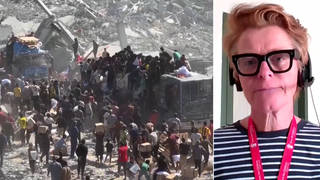

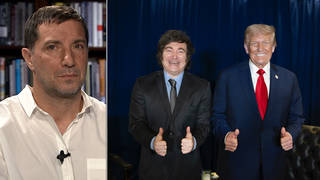
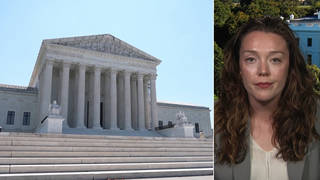





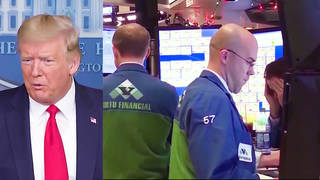
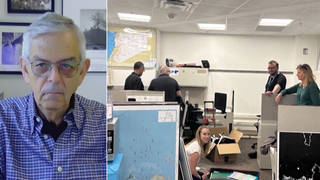
Media Options